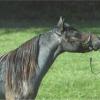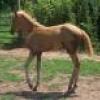What causes progressive color change in a 3 year old?
Forums
Pet DNA Services
Pet DNA Services AZ
http://www.petdnaservicesaz.com/Equine…
I don't really think it's necessary to test for brown unless you just want to. I think its pretty obvious that is what she is and with a black parent she would be A[sup]t[/sup]a
Trying to pull together the pieces
Thanks all for the help. As you can most certainly tell, I am NOT a color person but am really interested in learning what is happening!
So, Chloe is not black/white? Is this because she's showing brown around her mouth or something else I don't know to look for? (Of course, I'm quick to agree that right now she is NOT black!) Up until now, she's been very black looking. Honestly -- undoubtedly black & white!
Testing won't tell me what is causing the change? If I understand, I can (possibly) determine if she's black or brown, but not whether or not the roaning will stop or what is causing it.
Any guesses as to what she will finish up looking like? I adore this little mare and although I got her to be a part of "Team Oreo" (my black/white driving pony team), I'll happily drive her as a single. She does NOT match her teammate any longer.
How about the fact that her dark hairs are actually LIGHTER? Is that also linked to the KIT scenario or is it something else? It's like she's faded, but she's been blanketed all winter and there is NO sun here in the Pacific Northwest to fade her coat. I really don't know how to explain it any better.
Perhaps it is just 'fate' telling me that I am not destined to EVER have a matched pair!
The very distinct brown/red
The very distinct brown/red around her muzzle and eyes is what makes a her a seal brown and not black. That isn't just sunfading. It is really hard to say what will happen with the roaning. Some waver back and forth with level. Others get more roaned over time. To keep her remaining colored hairs as dark as possible, you want to make sure she is getting good nutrition (especially copper, cobalt and selenium if you are in the PNW) and you can also add fats to her diet (black oil sunflower seeds, ground flax seed, oils).
Diet...
She's on a good diet and Platinum Performance for supplementation. It's a good blend (and appropriate according to our vets). I will try adding more fat to her diet and see if that helps darken her coat.
If she is seal brown, does that also mean that she's bay? Her mane and tail are clearly black and have had none of the color change that her body is going through.
So many questions....so much for me to learn about. I honestly NEVER expected to see a 3 YO change color....
Which Platinum supplement?
Which Platinum supplement? Any hay grown in the PNW is basically deficient in several minerals.
Seal brown is a variation of the bay color expression. Dominant agouti (wild-type or A) is your 'normal' bay. Seal brown (At) is a mutation of the agouti allele that expresses as red only in the 'soft spots' such as the muzzle, eyes and flanks. Recessive agouti (a) is black. Your mare is Ata (carries one brown mutation and one black mutation). The brown is dominant over black so the brown is what expresses.
Platinum Performance
Platinum Performance (http://www.platinumperformance.com/) We are aware of selenium/mineral issues and are careful to work closely with our vet team to make sure we've got the right balance for our critters. Our hay comes out of Eastern WA and is tested.
Let me see if I've got this straight -- Chloe is a dark bay with sabino? So, if I wanted to be sure, I would test for agouti and sabino 1? That says that her dam must also be agouti (since the sire is known to be black). The palomino grand sire must also be carrying agouti since it's black on the other side. Yes??
If you want to be sure, you
If you want to be sure, you can get agouti done; if you want to get more specific, you can get the brown test instead of agouti. But since she is obviously brown based on her appearance and since her sire is black, then your test results are going to say Aa. Given that she is a paint, she would not have sabino-1 as it hasn't been found in stockhorses.
As to the palomino grandsire, what was the maternal granddam? If the granddam was black, then yes, the brown mutation came from the palomino. If the granddam was bay or brown, then you can't tell for sure.
Granddam is registered black
Granddam is registered black (of course, we all know how that goes...my Chloe is registered as black/white tobiano).
Chloe - Seal brown with sabino (that cannot be tested for)...but since nothing else will put white on like my mare has developed, it doesn't really matter. Would that be a correct description of her color?
Next question -- is there any there any reason to test for cream? If her dam was a smokey black, would that have any impact on Chloe's color?
I have no plans to breed her, but if I did, would this sabino expression pass on or is it a toss-of-the-dice as to how much white would come out?
As a sidebar, we own a sabino TB (one of the last crop outs that the APHA registered). Her sabino roaning looks very different than Chloe's. I am guessing that it's highly variable...? Or different sabino's?
Actually I personally
Actually I personally wouldn't call Chloe sabino. Any of the KIT mutations, including tobiano, have the potential to cause roaning.
There is no reason to test for cream as a seal brown would be a brown-based buckskin if cream were present. Since both Chloe and her dam are not buckskin/brown-based buckskin, then they don't have cream.
Your thoroughbred is most likely a dominant white rather than a sabino. Do you have pedigree or pictures of it?
Djinn Chaser is the TB's
Djinn Chaser is the TB's name. Her sabino roaning isn't as widespread as what Chloe has, although Djinn has belly spots, wild zig zag on her face and roaned spots on her haunches. I'll find a photo (I have them but switched computers). I understand she owes her color to "Candy Spots". Her roaning isn't as "even" as Chloe's is.
So, any KIT mutation can cause Chloe's color? Are they all progressive? It still seems odd to me that she changed dramatically at three. Somehow it just seems like the color she was born with should stay with her (after she shed her foal coat). Obviously, that isn't the case.
Still, I NEVER would have guessed that she would change like this, given what she looked like before.
Seal Brown Tobiano? Is that the correct label for her? Chloe does have the sabino chin white and some zig-zag leg markings. No belly spots, though.
Sabino VS Dominant White (gosh, what I didn't know!)
When I read "dominant white", I assumed this meant "all white". However, as I did some reading, I now understand that it is the name for the mutation and that it doesn't mean "all white". Yes, my mare looks like the photos of the other TB's labeled as dominant white.
Djinn has an Irish Sporthorse daughter who has minimal white markings (small star and snip), but does have roan patches on her. No "sabino" kinds of markings, just these roan patches. I'm assuming this is related to the same.
How does "dominant white" behave when breeding? I ask because I'm breeding both of them to a Knabstrupper this year. While color is fun, I really like the stallion's body style and I think that will cross nicely with the mares (and that was the deciding factor when selecting him). That said, what will happen if/when leopard meets dominant white?
The splash is based on how
The splash is based on how her markings are bottom heavy and fall off to one side. That is a very splashy trait.
Dominant white is inherited as a dominant mutation hence the name. That is what differentiates it from sabino. Sabino is an incomplete dominant mutation. A lot of people start out thinking that DW is all white because of the name, but some DW horses have quite minimal expression. If your mare is dominant white, then she will pass on the pattern 50% of the time.
DW...????
A whole new thing to consider. What other identifiers (besides white) would I look for on my TB mare and her daughter to surmise whether or not they have DW (as opposed to some other white activity)? Are there patterns, etc. that I would look for?
The TB mare is roaned - probably 5%, with patches of denser roan spots. She has lacing on her back (not rain rot...she was blanketed and protected all winter). She has one roan spot right at her tailhead but her tail isn't impacted. She has a LOT of white on her face - both roaning and this zig zag activity on the side of her head (which is why APHA took her..easier to document than to clip those belly spots!). She has belly spots. Related or not - her coat is metalic in sheen. Copper penny color, but really metalic looking. She is 11 and her roaning has varied some from year to year. It didn't show up immediately.
The daughter is (what I now understand!!) seal brown. She's nearly black on top, with the light brown around her nose/soft areas. She has a snip, one sock. But, she has roan spots - but her roaning is limited to the specific areas. Her dam's is widespread with patches of denser roaning. Will 'O Wisp has no sign of roaning outside her spots (she is 5 years old so I'm thinking that she's not going to change).
If this is DW, is there any breeding risk in it?
(yes, I admit it...I do not know about color! but, am trying to learn!)
Lethal white is related to
Lethal white is related to the frame (frame "overo") mutation. It causes the splotchy white body patches surrounded by body color. Two copies of the mutation causes the Lethal White Overo Syndrome foals that die within a couple days of birth. Unless you have proof that both parents are LWO-negative, I recommend any horse of breeding from known/potential LWO carrying breeds or of unknown breeding to be tested for it.
Dominant white is hypothesized to be embryonic lethal when homozygous. This means that an embryo that is WW would be non-viable and be resorbed, thus all you'd see is the mare coming back into heat.
Your TB mare sounds like a classic DW phenotype. Her daughter sounds like a possibility as well. Pictures would be best to determine though.
KIT and the mutations surrounding it is a young and ever expanding knowledge base right now, so we are all learning as we go at this point.
Thank you for your patience with my learning...
I will take good photos of Djinn & Will 'O. I have photos, but I can't find them (changed computers).
What makes Djinn's roaning sound like DW and Chloe's not? What would I look for that tells me the difference? Is it the breed (TB vs Paint)? Seems like many of the DW examples were TB.
Thanks again!




Both she and her mom are
Both she and her mom are browns, not black. The roaning looks like it is KIT related (KIT being the location of tobiano, sabino, dominant white and maybe rabicano).